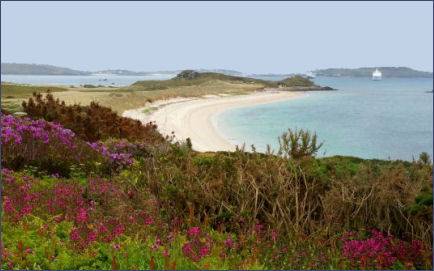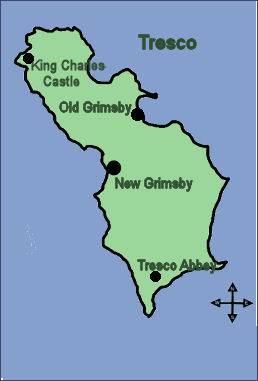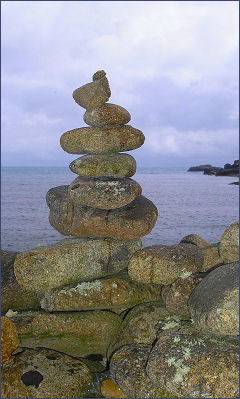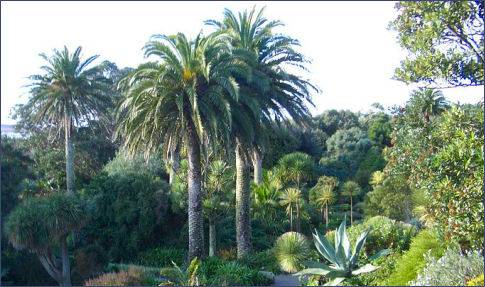Tresco
OS grid reference :- SV 893 421

 Situated less than 30 miles off the Cornish coast, beautiful Tresco island is the second largest island of the Isles of Scilly
Situated less than 30 miles off the Cornish coast, beautiful Tresco island is the second largest island of the Isles of Scilly
Measuring just two and half miles long and a mile wide, Tresco is one of the five inhabited island which, together with the 140 or so islands, islets and rocks, form the Isles of Scilly. The island's scenery is varied and includes rugged granite outcrops, heathland on the exposed north coast and mainly shell beaches in the east and south. There are bathing beaches at Pentle Bay, Appletree Bay, Gimble Porth, Hotel Beach, Green Porth, Gimble Porth, Rushy Porth.
Tresco is privately owned and bears the distinction of being Britain's largest privately-owned island. Augustus Smith, a wealthy merchant banker purchased Tresco from the Duchy of Cornwall in the mid-1930's. It is still held by his descendants the Dorrien Smith family. Today, Robert and Lucy Dorrien Smith live in the Tresco Abbey.
History and Legend are deeply rooted in the island's culture. Legend states that Tresco was the legendary 'Lyonesse' or 'land across the sea' the final resting-place of King Arthur. The belief that a lost civilisation lies to the east of Scilly has persisted for centuries, this is given credence by signs of an ancient forest lying hidden beneath tghe waters of Mount's Bay near Penzance where at low tide petrified tree trunks are still visible, the Cornish name for the bay is Carrack Looz en Cooz, meaning the grey rock in the wood.
The Norman King Henry I gave Tresco to Tavistock Abbey which established a priory on the island, it was abolished at the time of the Reformation. In ancient times Tresco and the nearby island of Bryher were known as Ryn Tewyn, a Cornish term meaning promontory of sand-dunes. In 1193 it was was granted to the abbot of Tavistock by Pope Celestine III the island became known as St. Nicholas's island. By 1305 it was called Trescau (farm of elder-trees). By 1540 this has changed to Iniscaw (island of elder-trees).
 The main settlements on Tresco are the villages of New Grimsby and Old Grimsby which are situated in central part of the island, where there is a shop and post office, an art gallery, a pub, and a hotel. Old Grimsby has a quay, at the southern end of which stands the Old Blockhouse, a sixteenth century fort built to defend the harbour from attack.
The main settlements on Tresco are the villages of New Grimsby and Old Grimsby which are situated in central part of the island, where there is a shop and post office, an art gallery, a pub, and a hotel. Old Grimsby has a quay, at the southern end of which stands the Old Blockhouse, a sixteenth century fort built to defend the harbour from attack.
 The ruined artillery fort of King Charles's Castle is situated on the highest point on the west side of Castle Down, overlooking New Grimsby harbour on the island of Tresco.
The fort was constructed between 1548 and 1551 to guard the narrow strait which leads past New Grimsby harbour and on towards St Mary's from French attack, it once contained a battery of guns and an accompanying garrison, designed to prevent enemy vessels from entering the harbour.
The ruined artillery fort of King Charles's Castle is situated on the highest point on the west side of Castle Down, overlooking New Grimsby harbour on the island of Tresco.
The fort was constructed between 1548 and 1551 to guard the narrow strait which leads past New Grimsby harbour and on towards St Mary's from French attack, it once contained a battery of guns and an accompanying garrison, designed to prevent enemy vessels from entering the harbour.
Cromwell's Castle, named after the Parliamentary leader, was constructed by Sir Robert Blake following the Parliamentary invasion of the Isles of Scilly in 1651. During the Civil War between 1642 and 1646, the Scilly Isles had been firm supporters of the Royalist cause of King Charles I, and rose in rebellion against Parliament in 1648. Tresco became a base for Royalist privateers and Parliament became concerned that the Dutch, then hostile to England, might exploit the situation. Accordingly, in 1651 they despatched Robert Blake and a naval force to retake the island.
At the south of the island lie Tresco Abbey Gardens, (pictured right) the famous sub-tropical garden has been described as a perennial Kew without the glass, it shrugs off salt spray and Atlantic gales to host myriad exotic plants, many of which would stand no chance of survival even on the Cornish mainland less than 30 miles away. Tresco Abbey Garden was established by the nineteenth century by Augustus Smith, it was originally a private garden within the grounds of his home.
Impressive Piper's Hole is a deep sea cave which is located at at the foot of Tregarthen Hill, at the north end of Tresco.The cave was once a famous smugglers haunt.
| Bryher Island | Eastern Islands | Gugh Island | Nornour Island |
| St. Agnes | St. Helen's | St. Martins | St. Mary's |
| Tresco |